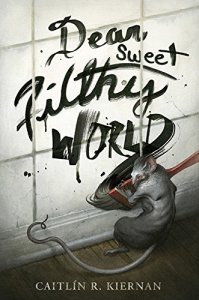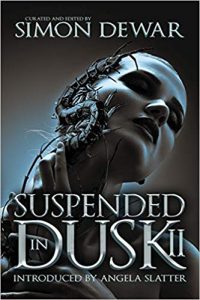Paul Di Filippo reviews Caitlín R. Kiernan
Dear Sweet Filthy World, by Caitlín R. Kiernan (Subterranean 978-1-59606-819-3, $40, 296, hardcover) March 31, 2017
 Although Kiernan has produced many fine novels, I think it’s safe to say that most of her fans think of her as one our finest and most productive writers of short stories. And so this new collection, her fourteenth, will certainly be received with much delight and acclaim. Containing nearly thirty tales, this handsome volume incidentally proves once again that Subterranean Press continues to be one of the most generous, savvy, elegant and creative publishers around.
Although Kiernan has produced many fine novels, I think it’s safe to say that most of her fans think of her as one our finest and most productive writers of short stories. And so this new collection, her fourteenth, will certainly be received with much delight and acclaim. Containing nearly thirty tales, this handsome volume incidentally proves once again that Subterranean Press continues to be one of the most generous, savvy, elegant and creative publishers around.
The stories are all fairly recent, having appeared from 2009 to 2014. And since the majority of them saw life in the pages of Kiernan’s Sirenia Digest, her for-patrons-only production, chances are great that they will be new to most of us. I’ll try to say at least a few words about each, to illustrate Kiernan’s various modes and themes and angles of attack.
Reminiscent of the body-horror approach of Kathe Koja or Michael Blumlein, “Werewolf Smile” concerns a predatory artist named Perrault, and the havoc he wreaks in the life of his complicit accomplice, a woman named Eva. Narrated by Eva’s mournful lover, the story shows Kiernan’s fondness for louche contemporary settings and the world of outsider art. But meanwhile, at the other end of the spectrum, our second tale, “Vicaria Draconis,” is primo Clark Ashton Smith, with exotic priestesses, dragons and sacrificial rites.
Next comes some pure science fiction, as we witness tech-mediated astral time travel in “Paleozoic Annunciation,” and its all-too-corporeal fallout. A hitchhiking woman in “Charcloth, Firesteel, and Flint” proves to be a demiurge who delivers a potent lesson to the young man who picks her up. “Shipwrecks Above” has the flavor of a Mitteleuropan fable to it, as we ponder the fate of “a woman who had the great misfortune to attract the attentions of something that was not only a man.” Red Riding Hood is a powerful symbol for Kiernan, as we saw in the first story, and the icon crops up again in “The Dissevered Hearts.” Here we find, I think, a small but pivotal autobiographical mission statement concerning Kiernan’s favored impressionistic story-telling approach. “I constantly marvel at those who think…in linear narratives…when the human mind seems to churn, and our dreams, no matter how filled with revelation, appear to me no more ordered than a scattering of autumn leaves.”
A woman longs madly to inhabit the transformative cloister of a butterfly’s cocoon in “Exuvium,” while “Drawing from Life” finds the artist’s model conveying a strangely illuminating story in the midst of their studio session. Perhaps the biggest surprise transition in style and genre occurs next, with “The Eighth Veil,” which is echt cyberpunk, full of tasty neologisms and chrome nastiness. Another artist—the quandaries, practical and esthetic, of the painterly, writerly life transfix Kiernan’s interest—experiences a queer meteorological phenomenon in his apartment, then is vouchsafed a vision in “Three Months, Three Scenes, With Snow.” The world of the cinema, another Kiernan passion, gets conspiratorial Pynchoneseque treatment in “Workprint,” about an odd and “obscene” still picture from a film that never was.
If Kiernan’s main preoccupation in this collection is the life of the artist, then secondary or equal to it is her fascination with the sea. Dedicated to the memory of Frank Frazetta, “Tempest Witch” is a prose poem to Neptune’s realm. Following hard on that is “Fairy Tale of the Maritime,” which give us, amidst some atypical humor, an oceanic myth told amongst the sentient fishes, but involving humans who trespass in that environment.
Resident for some years in Rhode Island, Kiernan uses her local knowledge, with some mild Lovecraftian tinges, to evoke Providence’s geography and history in “– 30 –“ where a stymied writer must meet with a plethora of occult creatures to resume her writing. If you got Ray Bradbury, musician Nick Cave, and film director Tod Browning to collaborate, the result might be “The Carnival is Dead and Gone,” a “travelogue” of sorts which explores the Sink, a Manhattan wunderkammer of abominations. And do I detect a trace of Philip José Farmer’s “Mother” in here as well?
Another somewhat CAS-style prose poem, “Scylla for Dummies” walks us around “the lady in the aquarium tank.” “Figurehead,” the story of a dryad, made me recall a now-forgotten fantasist, Thomas Burnett Swann. The story has some of Swann’s blithe melancholy. We next get a portrait of Hell and its inhabitants in “Down to Gehenna.” The ultimate damnation? “They are all free to leave, and yet none ever has.” Kiernan goes meta-textual, speaking of the story’s construction, in “The Granting Cabinet,” in which a woman enters a magical wardrobe with non-Narnia results. More Lovecraftian Rhode Island doings pop up in “Evensong,” with its brilliant conceit than an innocuous concrete block by the water’s edge, ignored by everyone, is a secret altar to elder gods.
The coordinates in the title of the next tale, “Latitude 41°21’45.89″N, Longitude 71°29’0.62″W,” indicate another seaside Rhode Island venue, where a strange mating between human and the elemental occurs. The story of a woman named Phyllida who is remade by a kind of nano-plague, “Another Tale of Two Cities,” possesses a kind of Greg Bear Blood Music vibe. A kind of Stapledonian cosmic perspective pervades the account of a ritualistic metamorphosis in “Blast the Human Flower.” A chameleonic entity chooses to live with a human woman in “Cammufare.” The life of a human changeling among the fay of Crystal City in “Here Is No Why” serves well to evoke Michael Swanwick’s notion of “hard fantasy.”
Is it a girl or a dragon—or something else entirely—that the sorceress of “Hauplatte/Gegenplatte” keeps in a cage? We don’t know for sure, even by story’s end, but the enigma is everything here. Yet more littoral Rhode Island spookiness fills the first-person narrative of “Sanderlings.” And we wrap the volume with “Interstate Love Song (Murder Ballad No. 8),” a kind of demented noir “Jim Thompson writes an episode of The Twilight Zone” performance.
The heterogeneous tales assembled in this collection display Kiernan’s large but tightly interlocked range of interests. Outsiders, art, the elements, transcendence, sex, love, failure, responsibility. She writes always with tactility, clarity, inventiveness and surprise, conjuring up weirdness out of the mundane, and lifting the veil of the exotic to reveal a common heritage of humanity. These stories stand out as passionate and real.








A bit puzzled with the first sentence: “Although Kiernan has produced three fine novels…” – surely more than three of her novels can be considered fine?!
Anther excellent review by Paul Di Filippo. Thanks for publishing his work, I look forward to reading him in this publication.
I hastily misread her entry at ISFDB, and believed that was the sum total of her novels! My mistake!